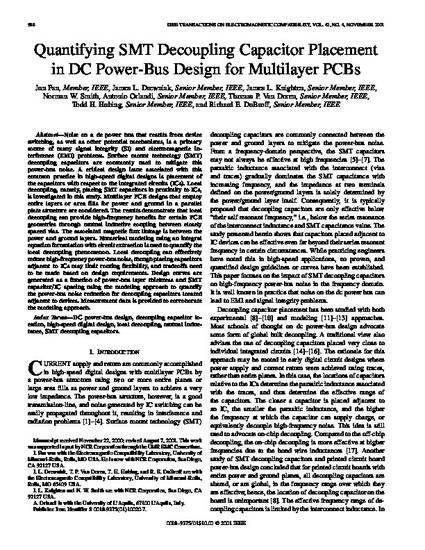
Noise on a dc power-bus that results from device switching, as well as other potential mechanisms, is a primary source of many signal integrity (SI) and electromagnetic interference (EMI) problems. Surface mount technology (SMT) decoupling capacitors are commonly used to mitigate this power-bus noise. A critical design issue associated with this common practice in high-speed digital designs is placement of the capacitors with respect to the integrated circuits (ICs). Local decoupling, namely, placing SMT capacitors in proximity to ICs, is investigated in this study. Multilayer PCB designs that employ entire layers or area fills for power and ground in a parallel plate structure are considered. The results demonstrate that local decoupling can provide high-frequency benefits for certain PCB geometries through mutual inductive coupling between closely spaced vias. The associated magnetic flux linkage is between the power and ground layers. Numerical modeling using an integral equation formulation with circuit extraction is used to quantify the local decoupling phenomenon. Local decoupling can effectively reduce high-frequency power-bus noise, though placing capacitors adjacent to ICs may limit routing flexibility, and tradeoffs need to be made based on design requirements. Design curves are generated as a function of power-bus layer thickness and SMT capacitor/IC spacing using the modeling approach to quantify the power-bus noise reduction for decoupling capacitors located adjacent to devices. Measurement data is provided to corroborate the modeling approach.
- EMI Problems,
- ICs,
- SMT Capacitor/IC Spacing,
- SMT Decoupling Capacitor Placement,
- Capacitors,
- Circuit Extraction,
- Circuit Noise,
- Closely Spaced Vias,
- DC Power-Bus Design,
- Design Curves,
- Device Switching,
- Digital Circuits,
- Electromagnetic Compatibility,
- Electromagnetic Coupling,
- Electromagnetic Interference,
- Electromagnetic Interference Problems,
- High-Frequency Power-Bus Noise,
- High-Speed Digital Designs,
- Integral Equation Formulation,
- Integral Equations,
- Integrated Circuits,
- Local Decoupling,
- Magnetic Flux Linkage,
- Multilayer PCBs,
- Mutual Inductive Coupling,
- Parallel Plate Structure,
- Power Supply Circuits,
- Power-Bus Noise,
- Power-Bus Noise Reduction,
- Printed Circuit Layout,
- Routing Flexibility,
- Signal Integrity,
- Surface Mount Technology,
- Decoupling Capacitor Location,
- High-Speed Digital Design,
- Mutual Inductance,
- SMT Decoupling Capacitors
Available at: http://works.bepress.com/thomas-vandoren/84/